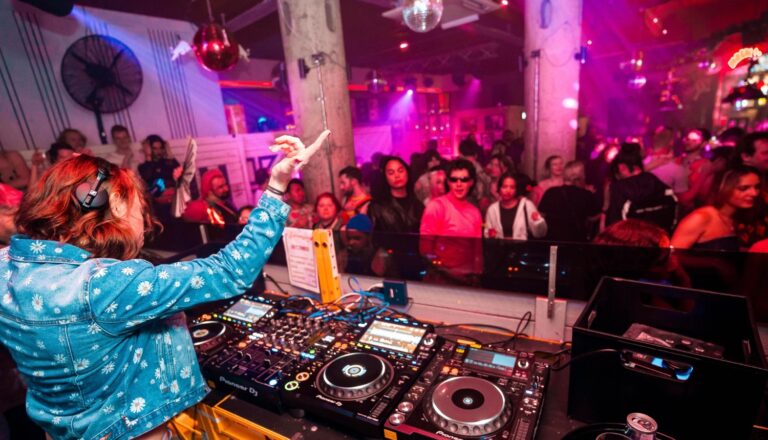
Trocks in frocks
If you’re at the State Theatre in the coming weeks for a performance of drag ballet troupe The Trocks, be warned a fifty-something American man might be standing in the foyer eavesdropping on your conversation.
That man is Tory Dobrin, artistic director of Les Ballets Trockadero de Monte Carlo, or The Trocks as they are better known. He sometimes slips out from backstage and into the foyers of theatres where the ballet is being performed, just so he can listen to the real responses of audiences.
Dobrin is used to The Trocks provoking a range of reactions. When he joined the company as a dancer in 1980, he was told he was ruining his career and that no one would ever take a drag ballet company seriously.
Twenty-five years later, and 31 years after their first performance, The Trocks continue to play to sell-out audiences around the globe.
Many people who come along to see us think it will just be a very camp, non-technical ballet show, Dobrin says from his New York home just days before travelling to Australia. When they see there is an element of camp and a wide range of comedy, and that the dancing is so good, they are often surprised.
I sometimes stand in the lobbies and hear people exclaim, -˜I had no idea they were such good dancers!’ Some of the dancers can do the very difficult things very well, and do them just as effectively as female dancers. These are very good ballet dancers and are very good at what they do.
The troupe of 18 male dancers, who Dobrin adds are primarily gay, but not totally, perform in tutus, wigs and make-up as they dance en pointe to such popular ballet classics as Swan Lake, Don Quixote and La Bayadere.
While all the dancers are facially clean-shaven, body hair is a matter of choice. Many of the most popular dancers sport a healthy growth of chest hair under their tutus.
Body hair is strictly personal, says Dobrin. We are not trying to get the audience to think we are female. We are male, wearing female costumes.
Surprising audiences with their talent and winning over even their toughest critics is nothing new for The Trocks. The all-male troupe was considered little more than a novelty act when they began in 1974 in New York. These days, they are regularly feted by the likes of the New York City Ballet and the Royal Ballet in London.
The problem was it was drag, and drag was not as popular then as it is now, he says. Things have changed and times are different. Our audiences have always been very enthusiastic, but the changes really came from the critics and the dance community.
Until the early 1990s, no living choreographer would allow us to do their work. Now, we are bringing in choreographers to work with us. For instance, Merce Cunningham, the modern dance artist, gave us one of his works, and a few years back we did one of Agnes de Mille’s works. That simply would not have happened before.
The Trocks will be making their sixth visit to Australia on this tour, marking the second time they have performed in Sydney. Their last visit was in March 2002.
The troupe’s origins can be traced back to the post-Stonewall era of New York. In 1970, Charles Ludlam of the Ridiculous Theatrical Company wrote a play in which he featured a drag ballerina, played by dancer Larry Ree.
Two years later, Ree and two other dancers formed their own dance troupe, the Trockadero Gloxinia Ballet Company, a combination of dance, camp, drag, and theatre. Two years later, four members branched off to form Les Ballets Trockadero de Monte Carlo, with as much focus on the choreography and dancing as on the drag satire.
We are probably one of the few professional theatre groups which came out of the Stonewall era, says Dobrin. We have this lineage that goes back to that time, so we have permeated the gay community and we have always had a gay sensibility.
For a primarily gay theatre company that has survived the past 30 years, the spectre of AIDS took a devastating toll on The Trocks in the 1980s and 1990s.
Dobrin recalls a cast photo of 14 dancers during a 1982 tour. Within a few years, 10 dancers in that photo were dead from AIDS-related illnesses.
It touched all our lives and it was a terrible time, he recalls. The quality of the show went down because so many people were sick. There were some tours we did not even know if we could complete because our dancers were so unwell.
But everyone learns how to recover, and we spent most of the early 1990s learning how to cope, both emotionally and physically. Times have changed and I think society in general is coping better as well these days.
Having lost many members to the virus, The Trocks regularly perform at AIDS benefits throughout the US, Canada and Europe, including the famous Life Ball in Vienna. If we get asked, we do it -“ it’s as simple as that, says Dobrin.
The Trocks performance on Thursday 6 October will be a benefit for the Bobby Goldsmith Foundation, with The Trocks and the Sydney Symphony Orchestra donating $10 from every ticket sold to the HIV/ AIDS charity organisation.
The Trocks perform at the State Theatre from 5 to 16 October. Book at Ticketek on 132 849 or at the Ticketek website.









